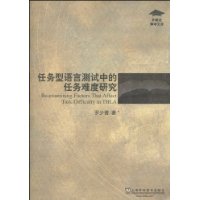內容簡介
 《任務型語言測試中的任務難度研究》
《任務型語言測試中的任務難度研究》“任務”被認為是評價學習者語語言運用能力的有效工具,但如何確定任務的難度卻一直是個懸而未決的問題。《任務型語言測試中的任務難度研究》在收集大量相關數據的基礎上,系統研究了這一課題,構建了以“輸入-信息處理-輸出為核心的任務難度分析框架,並利用一系列綜合因素對測試任務進行難度分析。這一研究為分析語言測試中的任務難度提供了可靠的理論依據,為測試者選擇任務提供了分析的模板,《任務型語言測試中的任務難度研究》對於如何進行任務型語言評價研究具有較高的參考價值。
圖書目錄
Chapter 1 Introduction
1.1 The Nature of the Problem
1.2 Defining the Problem
1.3 Purpose of Investigations
1.4 Significance of the Study
1.5 Organization of Thesis
Chapter 2 English Teaching and Language Testing in China
2.1 English Education in China
2.1.1 Student Population
2.1.2 Teacher Resources
2.1.3 Instructional Time for Language Learning
2.1.4 Management System
2.1.5 Textbooks and TeachingResources
2.1.6 Trends of Development
2.2 Communicative Language Teaching and the National English
Curriculum Standards
2.2.1 Communicative Language Teaching
2.2.2 The National English Curriculum Standards
2.3 Current Problems in English Teaching in Schools
2.3.1 The Curriculum Objectives and Language Assessment
2.3.2 Curriculum, Teaching and Testing: Problems
2.4 Task-Based Approaches to the Problems
2.4.1 Task-Based Language Teaching: Challenges
2.4.2 Task-BasedAssessment
2.5 Summary
Chapter 3 Literature Review: Language Testing, Task-Based Assessment, and Task Difficulty
3.1 Language Testing: Issues and Problems
3.2 Communicative Language Testing
3.2.1 Basic Issues
3.2.2 Communicative Tests. Models
3.3 Task-Based Approaches and Performance Assessment
3.3.1 Some Research Questions in Task-Based Approaches
3.3.2 Task-Based Approaches to Testing
3.3.3 Cognitive Dimensions: Information-ProcessingApproaches
3.3.4 Implications for Language Assessment
3.4 Assessing Task Difficulty
3.4.1 Defining Task Difficulty
3.4.2 Sequencing Tasks : Rationale and Task Difficulty Factors
3.4.3 Designing Tasks
3.5 Task Difficulty Matrix
3.5.1 The Norris-Brown et al. 's Studies
3.5.2 Problematizing Norris et al. 's Matrix
3.6 Rater Training and Objective Measures
3.6.1 Task Difficulty Matrix: Rater Training
3.6.2 Measuring Task Performance: The Discourse Analysis Measures
Chapter 4 Research Methods
4.1 Research Design
4.2 Method
4.2.1 Participants
4.2.2 Effective Tasks
4.2.3 Establishing the Difficulty of Tasks
4.2.4 Qualitative Analyses
4.2.5 Rater Training
4.2.6 Measuring Student Written Performance
4.3 Data Summary and Data Analysis
4.3.1 TBA Reliability
4.3.2 TBA Validity
4.3.3 Data Analysis
Chapter 5 Task Difficulty Matrix I: Evolving the IPO Task Difficulty Matrix
5.1 Application of Norris etal. ’s Matrix
5.1.1 Study One: Application of Norris et al.;’s Matrix
5.1.2 Studies Two, Three, and Four: Applications of the Norris et al.’s Matrix
5.2 The Input-Processing-Output Task Difficulty Matrix
5.2.1 Establishing the Matrix: Input-Processing——Output by Content-Form-Support
5.2.2 Study Five: Applying the IPO-CFS Task Difficulty Framework
5.2.3 StudySix: Ref'ming the Task Difficulty Framework : IPO by Extended CFS
5.2.4 Study Seven: Ref'mingthe Task Difficulty FramewOrk: IPO by Extended CFS
5.2.5 Self-Report Written Data
5.2.6 Study Eight: Refining the Task Difficulty Framework: Integrated IPO by ILPS
5.3 Task Difficulty Component Analysis
5.3.1 Component Analysis and the Refined IPO Matrix
5.3.2 StudyNine: Refming the Task Difficulty Framework : IPO by Reduced ILPS
5.3.3 StudyTen: Ref'ming the Task Difficulty Framework : IPO by
Reduced ILPS
Chanter 6 IPO Task Difficultv Matrix II. Dimensions and Components
6.1 The Construction of the Task Difficulty Matrix
6.1.1 Definitions of Dimensions and Their Characteristics
6.1.2 Definitions of the Task Components in Operational Terms
6.2 ACompafison between Brown et al. 's Matrix and the IPO Task Difficulty Matrix
6.2.1 Similarities
6.2.2 Differences
6.3 The Original Research Questions
6.3.1 Research Question 1
6.3.2 Research Question 2
6.3.3 Research Question 3
6.3.4 Research Question 4
6.4 Summary
Chapter 7 Rater Training for IPO Task Difficulty Matrix
7.1 Rationale
7.2 Study 11: A Pilot Study for Rater Training
7.2.1 Materials and Raters
7.2.2 Procedures
7.2.3 Results
7.3 Study 12: Establishing Expert Ratings
7.3.1 Tasks and Instruments
7.3.2 Experts and Procedures
7.3.3 Results
7.4 Study 13: Rater Training
7.4.1 Raters and Materials
7.4.2 Procedures
7.4.3 Results
Chapter 8 Discourse Measures for Student Performance
Chapter 9 Conclusions and Implications
References
Appendices
……
